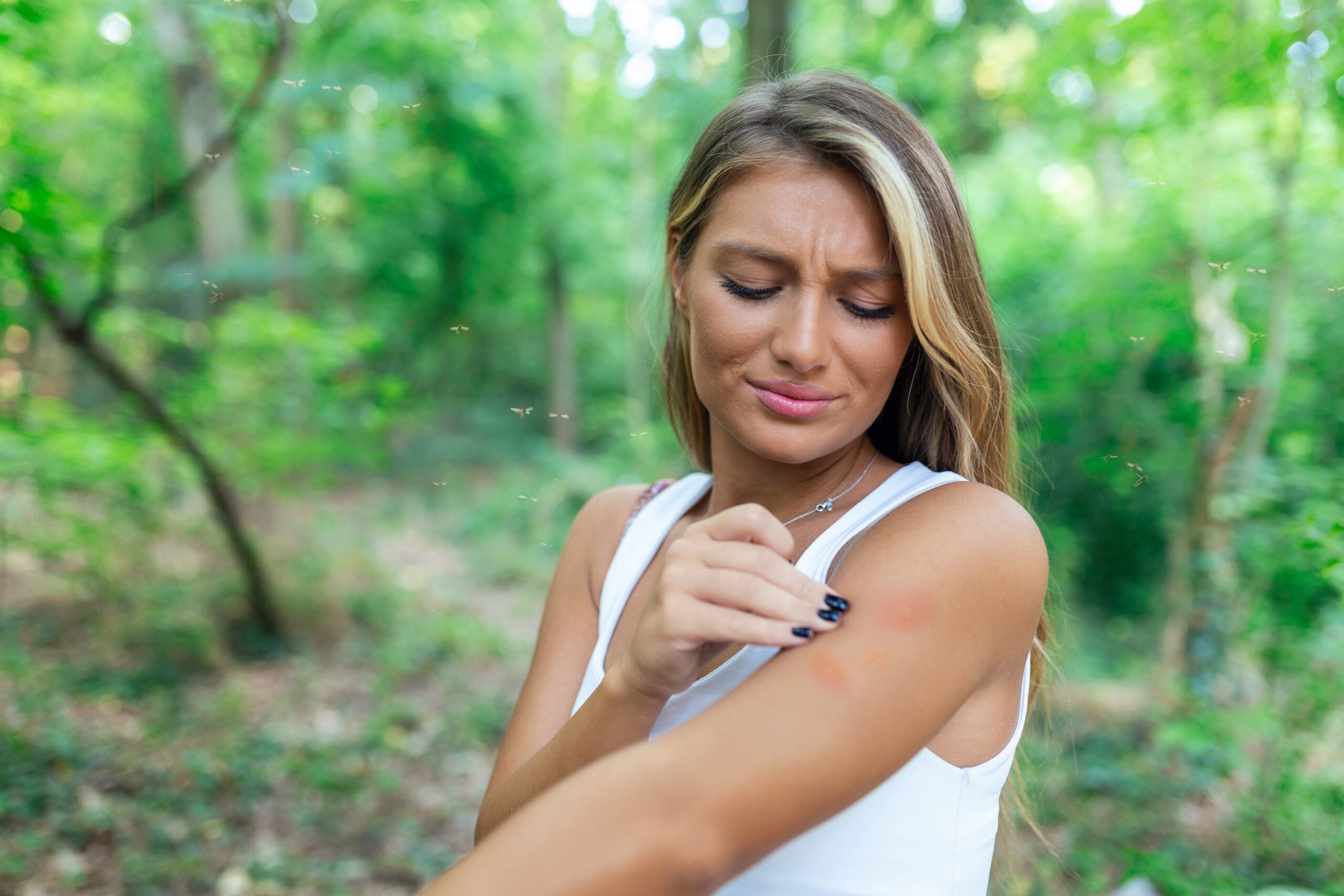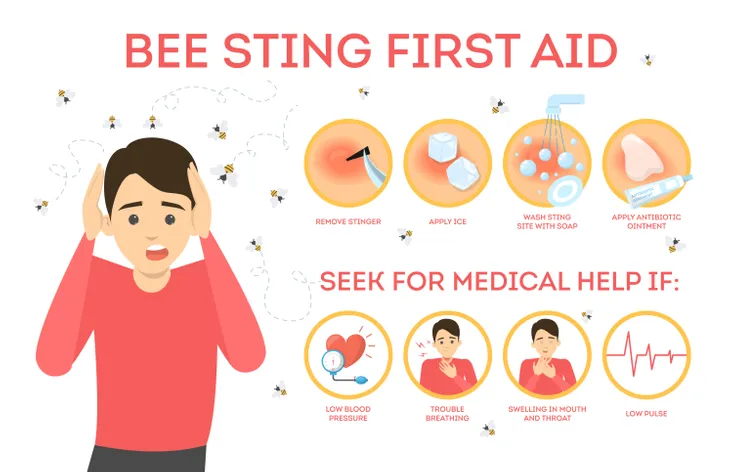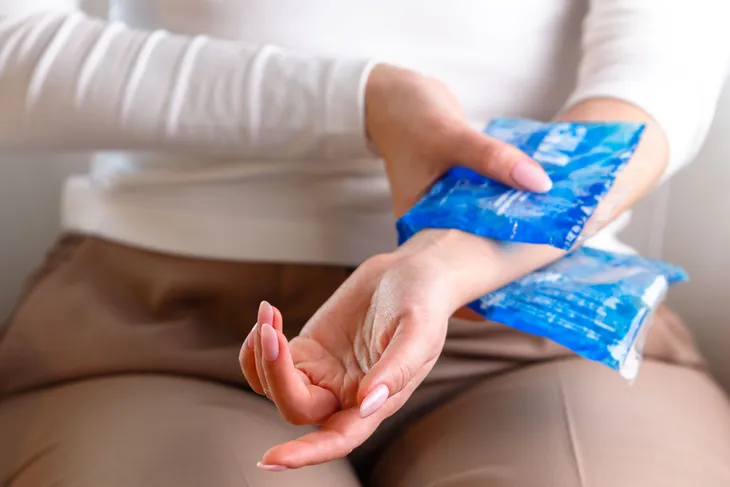- Most of the time bee stings are harmless and can be treated at home with some basic first aid.
- However, if a person has an allergic reaction, it could require emergency medical treatment.
- To treat a sting, gently remove the stinger, wash with soap and water, and apply a cold compress to reduce swelling.
- Avoid wearing bright or floral prints, seal food, toss garbage, wear close toe shoes, and be mindful when outdoors.
Bees are essential for not only the wellbeing of the planet, but our health too as they play an important role in nature’s ecosystem. The honey they produce has medicinal properties and their role as pollinators makes them vital for our food supplies, explains Medical News Today.
But let’s face it, they can also be a huge nuisance! Bees can sometimes make enjoying time outdoors difficult, especially if it ends in a sting. Most of the time, these stings are harmless (aside from the pain). But an allergic reaction can be dangerous. Here’s everything to know about bee stings, including the symptoms, risks, treatment options, and some prevention tips…
What is a Bee Sting?
We’ve all encountered a few bees here and there, particularly in the summertime. Some people might have even been stung once or twice! While we know their stings most certainly hurt, what exactly happens when a bee stings us? While wasps and other insects can sting us, the most common sting is from honeybees, says Medical News Today. The sting that most often causes an allergic reaction (in the U.S.) is from yellow jacket wasps.
When a bee stings it releases venom from a sac attached to its barbed stinger. “The wasp’s is similar but with a smooth stinger. When a bee or wasp stings, the sac contracts, pumping venom into the tissue,” writes the source. The sting results in a sharp pain alongside a puncture wound or laceration. “The venom in a bee or wasp sting induces a local toxic reaction at the site of the attack.”
Mild Reaction
Bee stings can produce different reactions. The type of reaction a person will have depends on whether or not they are allergic. It can range from temporarily painful to a severe allergic reaction. According to the Mayo Clinic, just because a person has one type of reaction doesn’t mean they will have the same the next time, or that it will be as severe.
Most people have a mild reaction with minor symptoms. In this case, the Mayo Clinic says a person will feel a sharp burning pain at the sting site. They might develop a red welt around the area or experience swelling. These symptoms should go away within a couple hours.
Moderation Reaction
A moderate reaction isn’t quite as severe as an allergic reaction, but a step up from mild symptoms. In this case, the Mayo Clinic states a person will have extreme redness and swelling at the site of their sting. This swelling could last for a day or two. In most cases, the symptoms resolve entirely in 5 to 10 days.
“Having a moderate reaction doesn’t mean you’ll have a severe reaction the next time you are stung,” says the source. “But some people develop similar moderate reactions each time they’re stung.” If this happens, talk to your doctor about potential treatment or prevention options, especially if the reactions get more severe each time.
Severe Allergic Reaction
A severe allergic reaction, also known as anaphylaxis, should be taken very seriously as it can be life threatening. If a person is having a severe allergic reaction to a bee sting they will need emergency treatment, warns the Mayo Clinic. Thankfully, it’s not common. Only a small percentage of people who are stung by a bee will develop anaphylaxis.
The Mayo Clinic provides the following as signs of anaphylaxis:
- Skin reactions, including hives and itching and flushed or pale skin
- Difficulty breathing
- Swelling of the throat and tongue
- A weak, rapid pulse
- Nausea, vomiting or diarrhea
- Dizziness or fainting
- Loss of consciousness
Even though the risk is small, if someone develops anaphylaxis once, there is a 25 to 65-percent chance they will again, reports the Mayo Clinic. People who’ve had this reaction before, should talk to their doctor about potential prevention measures, such as immunotherapy (allergy shots) to reduce the chances of it happening again.
Multiple Bee Stings
While it might not always seem that way, bees and wasps are not typically aggressive. They usually only sting in self defense. Most of the time, a person will only receive one sting, possibly two if they are unlucky. However, if a person disrupts a hive or encounters a swarm of bees, they may get stung multiple times.
According to the Mayo Clinic, certain types of bees are more likely to swarm and sting in a group, such as the Africanized honeybees. If a person gets stung more than a dozen times, they are at risk of a toxic reaction due to an overload of venom. This will likely cause them to get sick. It can also cause nausea, vomiting or diarrhea, as well as headache, vertigo, convulsions, fever, and dizziness or fainting.
Multiple bee stings can result in a medical emergency for children, older adults, and individuals with heart or breathing issues, warns the Mayo Clinic.
Potential Complications
Of course the most common complication associated with a bee sting is a severe allergic reaction which requires urgent medical attention. A person who is having a severe allergic reaction is at risk for anaphylactic shock which can occur quite quickly, warns Medical News Today.
Anaphylaxis is a severe allergic reaction that can be life threatening. Symptoms include the following: hives, swelling of the face or mouth, anxiety or confusion, blue or white lips, dizziness, vomiting, wheezing, fast and shallow breathing, clammy skin, and fainting or loss of consciousness.
If you’ve had an allergic reaction to a bee sting in the past, there is a 60-percent chance it will happen again (either with similar symptoms or worse). Medical News Today suggests people with the greatest risk carry a “bee sting kit” including the medication needed to treat an allergic reaction.
Steps to Treat a Bee Sting
We all try to avoid getting stung by a bee, but unfortunately it does happen. If it does, remember to stay calm and walk away from the area. While bees tend to only sting once, wasps and hornets can sting multiple times.
The first thing to do is to pull out the stinger (if it’s there) because the longer it stays in the skin, the more venom it releases which is what causes that pain and swelling, says the American Academy of Dermatology Association (AAD). Avoid using tweezers as they can squeeze more venom into the skin. Instead, scrape over it with your fingernail or a piece of gauze.
Wash the area with soap and water, then apply a cold pack to reduce the swelling. The source also notes to keep an eye out for swelling on other parts of the body. If it moves to the face or neck, it might indicate an allergic reaction which requires a trip to the emergency room. You may take pain medication if necessary.
Home Remedies for Bee Stings
Most bee stings require little treatment. Oftentimes some basic first aid will do the trick, but there are some home remedies that can provide additional relief if necessary. The obvious ones are a cold compress, possibly some essential oils (tea tree oil, witch hazel, thyme oil, rosemary oil, or lavender oil). There’s also aloe vera gel and calamine lotion, says Medical News Today.
Healthline also suggests trying honey to help with wound healing and infection prevention. It cites a 2021 research review which reported that medical-grade honey (MGH) lowers inflammation and has strong antimicrobial properties.
The Centers for Disease Control and Prevention (CDC) provides this recipe for mosquito bites which Healthline says might also work on bee stings. And while there’s no scientific evidence behind toothpaste or apple cider vinegar, the same source provides these as two other possible remedies to try.
Medical Treatment for Allergic Reaction
Aside from any home remedies, the basic treatment for a bee sting is just some local wound care, says WebMD. This entails cleaning and applying antibiotic cream. If any stingers remain, they will be removed. You may be given an antihistamine to treat any itching, as well as some pain medication.
Healthline warns against scratching the area afterwards because that can lead to an infection. Aside from taking any anti-inflammatory or antihistamine medications, you can also apply a cold compress to reduce pain and swelling. Try not to put the ice directly on the skin and apply for 20-minutes or less.
Emergency Treatment for Allergic Reaction
If a person is having a severe allergic reaction to their sting or have developed anaphylaxis, they first and foremost need to go to the hospital. Bystanders should call 911 immediately. Once they have been taken to the hospital, they will likely receive a shot of medication to treat their reaction. This medication counters the body’s allergic response and helps stabilize blood pressure. If the person has this medication on them prior to getting medical assistance, give it to them.
At the hospital they might receive oxygen therapy to help with their breathing and be given some antihistamines to calm their immune system down. “They reduce histamines, substances in our blood that cause allergy symptoms,” writes Healthline. Another medication that can be used are corticosteroids to lower immune system activity and reduce inflammation.
Who’s at Risk for Bee Stings?
Essentially anyone is at risk for getting stung by a bee, but the risk is heightened for people who work or spend a lot of time outside. There’s also more of a risk for people who live in an area where bees are active or where there is a beehive nearby, says the Mayo Clinic.
When it comes to having an allergic reaction, people who’ve had one in the past, are more likely to have another one in the future. The Mayo Clinic also warns that this is the case even if the reaction was minor. “Adults tend to have more severe reactions than children do and are more likely to die of anaphylaxis than children are,” writes the source.
When to Contact a Doctor
Most bee stings can be treated at home and require little care. The pain typically subsides in an hour or so with the area completely healing within a day or so. However, if you think someone is having a serious allergic reaction to their sting, it’s important to contact emergency services as soon as possible. “Anaphylactic symptoms like trouble breathing and a rapid pulse can quickly become life threatening,” notes Healthline. In this case they require medication to survive.
If the reaction is mild, but still concerning or the area isn’t healing within a reasonable amount of time, you can reach out to your doctor. While it’s uncommon, bee stings can sometimes become infected, says Healthline. If this happens you’ll need antibiotics prescribed by a doctor.
Prevention Tips
While there’s no surefire way to avoid bees altogether or even get rid of them for that matter, there are some simple steps people can take to reduce the risk of being stung. Firstly, don’t keep food around. The Cleveland Clinic notes that the top culprit for bringing bees around is food. To avoid luring them in with food, keep food covered, clean up dirty dishes, and remove the food as soon as you’re done eating.
Bees are attracted to flowers so it’s probably not a good idea to dress or smell like one! Avoid wearing floral scents (i.e. perfume, lotions) and dressing in bright colors. Also, don’t panic when a bee comes around. Emergency medicine specialist Baruch Fertel, MD, tells Cleveland Clinic that waving arms and causing a scene could actually increase your risk of getting stung. Instead, hold still until the bee goes away.
Lastly, anyone with a severe allergy to bees or any kind of insect sting should keep their prescribed medication with them at all times.
















